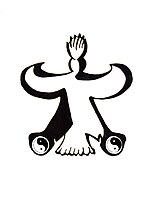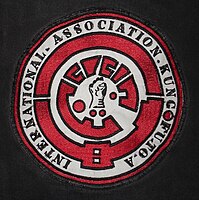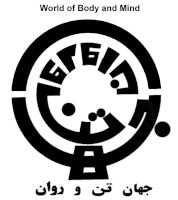Benutzer:Drhenry/Kung Fu To'A
English version: (TODO: translate from German to English)
[Bearbeiten | Quelltext bearbeiten]Kung Fu To'A is a Persian martial art, developed by Ibrahim Mirzaii in the 1960s. The term Kung Fu To'A consists of the Chinese terms Kung (hard work) and Fu (path, way), as well as To'A (thou com'st), derived from Farsi. Today Kung Fu To'A is the most popular martial art in Iran with about 200.000 members.[1]
Kung Fu To'A consists of about 73.000 techniques, combinations and reactions. Dynamic wavelike movements and strong accentuation of techniques (called shock, frequently finished by a twist) are characteristic for this martial art.
History
[Bearbeiten | Quelltext bearbeiten]Ibrahim Mirzaii is the founder of Kung Fu To'A. He developed this style in the 1960s in Iran and based it upon the main principles of traditional Asian martial arts.
Financially supported by shah Reza Pahlavi Mirzaii started a journey through Asia in order to learn different martial arts and to create a unique style, which should have Iranian characteristics. His journey layed the foundation of Kung Fu To'A.
During the revolution in Iran in 1978/1979 the shah was overthrown. Kung Fu To'A has been prohibited from this time on. Nevertheless many practised in secret, others fled during revolution to foreign countries. That's how this style spread in the following years worldwide. A few years after revolution Mirzaii survived an assassination after which he left Iran.
Grandmaster Mirzaii's whereabouts are still unknown. He refrained from Kung Fu To'A and created new styles called Kun Kafu Tawan and Pa Zar Bal upon To'A. In his opinion Kung Fu To'A shouldn't be taught any longer, whereupon several Kung Fu To'A masters dissociated themselves from Mirzaii.
Today there are Kung Fu To'A schools (also called temples) all around the world, e.g. in Germany, Italy, Portugal, Turkey and Canada. A couple of years ago this style was legalised again in Iran and is nowadays one of the most popular martial arts there. Nevertheless To'A is in other countries still a quite unknown style of Kung Fu. Several movies about e.g. Shaolin Kung Fu made these styles more famous than To'A.
The seven Forms
[Bearbeiten | Quelltext bearbeiten]
There are mainly seven forms in Kung Fu To'A. Instead of form terms like kata or line are in common usage as well. A form is a fix motion sequence composed of many different techniques, which serve as self-defence and attacks or follows energetic aspects. Each of these forms will be examined by at least one master. If a practitioner passes an examination he gets a stripe on his right breast of the training jacket.
Beyond the physical education each of the seven forms deals with a given philosophical topic.
- Anato'A
- Atado
- Soto
- Samsamae
- Mayana
- Kuanna & Vest Mayana
- The sixth grade of Kung Fu To'A consists of two forms: Kuanna and Vest Mayana (Vest Mayana is also called "Vest Ai").
- Vaymabato
Officially a green belt is given to To'A students after they passed the examination of the seventh form. When a student passes the examination for the master grade, a red jacket is handed to him. Originally further forms without weapons have been planned, based on the existing forms. Because of the given historical events (prohibition of Kung Fu To'A, attack on Mirzaii) only "Anato'A sabz" (also called green or brown Anato'A) was officially passed on. Since these additions to the system of Kung Fu To'A starting with Anato'A sabz haven't been completed, Vaymabato can be considered as a close. Thus, several schools already pass the black belt after the seventh form instead of the green belt.
There are, though, two additional weapon forms, which have been passed on: Sai and Rekeyma (Samurai sword).
Belt
[Bearbeiten | Quelltext bearbeiten]
The belt is of red fabric and has a broad coloured stripe in its middle. According to the student's level the middle stripe can be white, green, brown or black. The red belt is supposed to be worn only by Grandmaster Mirzaii.
A folded belt has on one side three folds of different sizes representing "Think well. Talk well. Act well.".
Philosophy
[Bearbeiten | Quelltext bearbeiten]Kung Fu is the world of motion, motion of power, motion of beauty, motion of justice and humanity, motion to a healthy society. Kung Fu is motion to pure thought, where its secret lies in the language of the soul. This means the path of heart, the (re)discovery of pure knowledge, which we already have in us. Kung Fu To'A practices use the body as a "portal" to this path. By powerful motion Kung Fu teaches you strength and courage to let go of known, to reexperience who you are and to realize the whole spectrum of your soul.
Another way to achieve self-awareness is meditation. It is used for cleaning your mind, freeing from thoughts to enhance presence and to face your ego.
An analogue to the path of pure heart and to the teachings of the seven forms of Kung Fu To'A can be found in Persian literature: "Conference of the Birds" by Fariduddin Attar.
Conference of the Birds - the Simorgh
[Bearbeiten | Quelltext bearbeiten]"Conference of the Birds" ("Manteq-ot-teir") by Fariduddin Attar is a Persian story about thousands of birds starting a journey through seven valleys to find Simorgh - king of the birds. The seven valleys are the valley of desire (let go of property), the valley of love (let go of learned moral concepts like "Good" and "Bad" and feeling the pure emotion of love), the valley of knowledge (breakout from familiarity and realizing the connection between body and mind), the valley of self-sufficiency (abandonment of knowledge and heart and to quest for new), the valley of unity (realize that everything in our world is connected to each other), the valley of confusion (establishes different perspectives on being and not-being, you realize your mortality and immortality at the same time) and at last the valley of death (achieving immortality by accepting to become part of the whole). Each of the seven valleys is a hurdle and represents an attribute the birds have to let go of to reach the Simorgh. The birds learn more and more about who they really are.
Of all birds only 30 achieve their goal and being there they realize that they are the Simorgh. The term "Simorgh" consists of the Persian words for "thirty" (si) and "birds" (murgh).
Symbolism
[Bearbeiten | Quelltext bearbeiten]One of the most common symbols of Kung Fu To'A is a falcon with spreaded wings. This could be originated in a tale about the Simorgh, where he spreads with one flap the seeds of the tree of life all over the world. Furthermore falcons are considered to be extremely beady-eyed and sharp-sighted. Their eye-sight, hunting abilities, grace and force at flying are outstanding characteristics.
"The falcon teaches us control of speed and motion, as well as patience. He represents recognizing opportunities and to act at the right time. He teaches us that we have to make great efforts to achieve great success. He represents leadership, prudence and caution. He stands for a fast, graceful mind and for how to use our mental capabilities more effectively to "catch" what we need and want the most by being more patient." [2]
- The following pictures show the most common symbols in Kung Fu To'A.
-
A falcon with spreaded wings. Commonly globes or Yin and Yang are shown in its claws.
-
Badge on the back of a Kung Fu To'A training jacket.
-
Circular arranged Persian writing meaning "world of body and mind".
Techniques
[Bearbeiten | Quelltext bearbeiten]A characteristic technique of this Kung Fu style is the so-called shock. The shock is a strong accentuation at the end of a motion. Being fast and precise is more important than pure physical strength for using this technique. Many techniques are finished by a (small) rotation to transfer maximum force to the imaginary opponent.
Furthermore the energy of the last applied technique (of your own or by your opponent) shall be used for the next technique. This is necessary for higher forms since they take very long and can be mastered only by applying dynamic techniques and a good breathing technique.
References
[Bearbeiten | Quelltext bearbeiten]- ↑ The History of the Iranian Martial Art Kungfu To’a. Abgerufen am 14. September 2010.
- ↑ Kung Fu To'A - The falcon. Abgerufen am 8. Oktober 2010.


